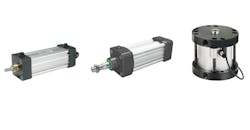Shortened Cylinder Lead Times Mitigate Downtime Costs, Speed Machine Construction
A plant supervisor makes a frantic call to his pneumatic cylinder supplier at 10:45 a.m. with a “line down” emergency due to a failed cylinder. He knows that his cost of an idled line is $80,000 per day, so getting back in operation as soon as possible is critical. Unplanned downtime can have a devastating impact on a manufacturing facility’s overall productivity and profitability. When pneumatic cylinders fail, the goal is to get production lines operating again quickly, in order to limit the financial and reputational damage.
The challenge is that often there is not an off-the-shelf replacement available. Because they are engineered to convert compressed air into linear motion, pneumatic cylinders are widely used in a range of automated manufacturing equipment and come in a wide range of construction types, including tie rod, compact, guided, round, and rodless. They are typically configurable with various stroke lengths, sensor options, cushions, mounts and rod locks. Getting the exact pneumatic cylinder hasn’t been easy.
Lead Time Reduction Programs
Fortunately, a growing number of cylinder producers are making big changes to help their customers get back into operation as soon as possible to avoid many of the costs associated with unplanned downtime. Similarly, they are working to deliver cylinders to machine builders who must make engineering changes based last minute changes from their own customers.
In the story above, the plant supervisor called the engineering support number for the cylinder manufacturer, expecting to hear bad news. Instead, the cylinder producer was able to enter the cylinder order into their single-flow production line and have it completed on the second shift. The cylinder producer processed the order, manufactured the cylinder and delivered it so the customer could install it and resume production in fewer than 12 hours.
Similarly, a distributor contacted the same cylinder producer at 6:00 pm on a Thursday. His customer needed parts immediately to clear a large-value machine build order before the end of the month. They needed five complex engineered units, including rod locks, to be shipped immediately. These cylinders went onto the production line at the start of first shift on Friday and were being boxed for UPS Red shipment to the West Coast by midday.
What makes high-speed order turnarounds like this possible? For Parker’s Pneumatic Division, it was a new lead time reduction program, designed to get equipment maintenance engineers and machine builders the cylinders they need promptly and cost-effectively so they can get their production lines back in operation or meet their customers’ delivery deadlines.
Parker recently redesigned the cylinder production lines at its Otsego, Michigan, facility to create a single continuous flow that maximizes cylinder quality while reducing lead times. Parker invested in equipment to speed production, including four piston rod machines, vertical CNCs, a saw for cutting cylinder components to length, and an annealer for heat treating. This new equipment allows for faster tool changes. The speed and flexibility of these new machines allows machining piston rods (longest lead time item) from scratch, in sync with the single-piece flow of the production line. New orders with shortened lead times can be fabricated quickly without disrupting the existing order workflow.
The exact lead time depends on the a few factors.
- Popular model numbers of NFPA cylinders with standard bore, strokes and mounts, which are available in stock for same-day shipment have the shortest lead times. What’s more, these in-stock cylinders cost less than non-stock cylinders, which in Parker’s case amounts to a 15% savings.
- Often an off-the-shelf model cylinder isn’t sufficient. If the base model is in stock, then a configured cylinder may not take long to produce. Assuming the supplier has the right manufacturing systems in place, the common modifications may take as few as three days and five days for more complex modifications related to stroke length, bore size, use of rod locks, etc. This level of service is of particular value to OEMs/machine builders who have a customer that needs a configured product immediately or who need to adapt to last-minute engineering changes from their end customers.
- Previously configured cylinders may be produced within hours, if the manufacturing system has the configuration stored and the setup is truly flexible. For example, Parker provides same-day shipment of any cylinder that has previously been configured using the online configurators for its popular 4MA, P1D, and LP Series. The enhanced production flexibility of the Otsego operation makes it possible to “break in” to the workflow to produce custom cylinders quickly and ship them immediately after production, with an additional fee.
Lead-time reduction programs are emerging as part of the manufacturing ecosystem, a partnership between plants and their machine component suppliers, so that plants may further minimize downtime. The associated costs typically include the wages of idled employees and any overtime costs required to make up for lost production. The cost of downtime can make a big dent in the bottom line when one adds in the cost of any product that must be scrapped and the rush repair costs for implementing any temporary “band-aid fixes.” Worse still, the damage to the manufacturer’s reputation among customers whose orders are delayed can have long-lasting consequences.
For more information, visit Parker's Pneumatics Division.
